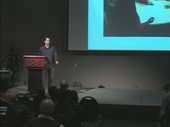Highlight
Workshop on Media Arts, Science, and Technology
Achievement/Results
The Workshop on Media Arts, Sciences, and Technology (MAST) was held in Santa Barbara, CA on January 29-30, 2009. The goal of this workshop was to bring together leading digital media researchers and practitioners who work at the intersection of arts and engineering, in order to explore key challenges and promising directions in digital arts, experiential media systems, creative environments, and emerging media technologies. The two-day workshop consisted of invited keynote presentations, short talks, poster sessions, media installations, demos, and panel discussions. The format provided ample opportunities for participants to interact and explore further collaborations.
The workshop was jointly hosted by NSF IGERT programs at Arizona State University (Experiential Media) and UC Santa Barbara (Interactive Digital Multimedia), and sponsored by the National Science Foundation. For both IGERTs, the workshop acted as a showcase of media research, but for the UCSB program, it was also an opportunity to unveil the Allosphere and the research possibilities therein. Over 130 people attended this workshop, nearly twice the number anticipated.
45 total papers and posters were presented, including a number of “hands-on” exhibitions and demonstrations of interactive digital media. Keynote speakers at the workshop discussed current topics in media research and introduced interactive applications for games, education, and modern trends in industry — including Nokia and Walt Disney corporations. Video proceedings of this workshop are available at http://mast.mat.ucsb.edu.
Address Goals
The First MAST workshop addresses the primary NSF strategic goal of Discovery in that it introduced innovative applications and research in interactive digital multimedia to a broader audience. For example, one research group present at the workshop was researching multimedia as a tool for educating autistic children and children with learning disabilities. They were able to demonstrate their application, a 16′×16′ intelligent space with interactive camera and sensor networks. Another research group was able to demonstrate various applications in the UCSB Allosphere, showing art-inspired ways to handle nanoscale data. Because so many trends in multimedia are moving towards interactive uses of the medium, a hands-on workshop like MAST allows scientists to actually experience the research they would otherwise only read about in journals.
To see how the MAST workshop addresses the secondary goal of Research Infrastructure Development, one need only look at the research being undertaken in the Allosphere (mentioned above). This laboratory/instrument remains a highlight of digital media research at UCSB (http://allosphere.ucsb.edu).
All of the presentations and papers from MAST are available for the general public, and the keynote speakers and exhibitions are archived in digital format for viewing.







